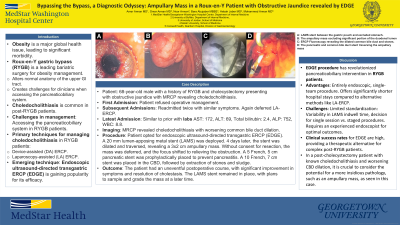Tuesday Poster Session
Category: Interventional Endoscopy
P4534 - Bypassing the Bypass - A Diagnostic Odyssey: Ampullary Mass in a Roux-en-Y Patient with Obstructive Jaundice Revealed by EDGE
Tuesday, October 29, 2024
10:30 AM - 4:00 PM ET
Location: Exhibit Hall E

Has Audio

Amer Arman, MD
MedStar Georgetown University Hospital
Washington, DC
Presenting Author(s)
Amer Arman, MD1, Omar Arman, MD2, Noor Arman, 3, Bara A. Abujaber, MBBS1, Hebah Jaber, MD4, Mohammed Arman, MD5
1MedStar Georgetown University Hospital, Washington, DC; 2University at Buffalo, Buffalo, NY; 3University of Jordan School of Medicine, Amman, 'Amman, Jordan; 4Mutah University, Amman, 'Amman, Jordan; 5Beaumont Health, Franklin, MI
Introduction: Obesity is a major health issue worldwide, leading to significant morbidity. Among the various bariatric surgeries available, Roux-en-Y gastric bypass (RYGB) is a premier choice. However, this procedure alters the normal anatomy of the upper gastrointestinal tract creating challenges for clinicians when accessing the pancreaticobiliary system, particularly in managing choledocholithiasis, a common issue in this cohort. To address these challenges, two primary methods are used: device-assisted (DA) ERCP and laparoscopy-assisted (LA) ERCP. Recently, endoscopic ultrasound-directed transgastric ERCP (EDGE) has gained popularity.
Case Description/Methods: We present the case of a 68-year-old male with a history of RYGB and cholecystectomy, who came in with obstructive jaundice. Imaging via MRCP confirmed choledocholithiasis. Initially, he refused operative management. He was readmitted twice again with similar symptoms, yet deferred intervention, specifically LA-ERCP.
On his latest admission, he again experienced RUQ pain but was afebrile. Lab results showed AST 172, ALT 69, T.bili 2.4, ALP 752, and WBC 8.8. MRCP revealed choledocholithiasis with worsening CBD dilation. He opted for EDGE over LA-ERCP. A 20 mm lumen-apposing metal stent (LAMS) was deployed and 4 days later dilated and traversed which revealed a 3x2 cm ampullary mass.
Without consent for resection, it was deferred, and we proceeded to relieve the obstruction. A 5 French, 5 cm stent was prophylactically placed in the pancreatic duct to prevent pancreatitis, followed by the placement of a 10 French, 7 cm stent in the CBD. Stones and sludge were then extracted. The patient had an uneventful postoperative course, with improvement in symptoms and resolution of his cholestatic picture. LAMS stent remained with the intention of sampling the mass and grading the invasion at a later time.
Discussion: EDGE procedure has revolutionized pancreaticobiliary intervention in RYGB patients as it is an entirely endoscopic and single-team procedure with the benefit of significantly shorter hospital stays. Although there is limited standardization and in LAMS indwell time, single session versus staged procedure; in the hands of an experienced endoscopist, it can offer therapeutic alternatives with high clinical success rates. In a patient status post cholecystectomy with a known stone, worsening CBD dilatation could raise concerns for another more insidious pathology.

Disclosures:
Amer Arman, MD1, Omar Arman, MD2, Noor Arman, 3, Bara A. Abujaber, MBBS1, Hebah Jaber, MD4, Mohammed Arman, MD5. P4534 - Bypassing the Bypass - A Diagnostic Odyssey: Ampullary Mass in a Roux-en-Y Patient with Obstructive Jaundice Revealed by EDGE, ACG 2024 Annual Scientific Meeting Abstracts. Philadelphia, PA: American College of Gastroenterology.
1MedStar Georgetown University Hospital, Washington, DC; 2University at Buffalo, Buffalo, NY; 3University of Jordan School of Medicine, Amman, 'Amman, Jordan; 4Mutah University, Amman, 'Amman, Jordan; 5Beaumont Health, Franklin, MI
Introduction: Obesity is a major health issue worldwide, leading to significant morbidity. Among the various bariatric surgeries available, Roux-en-Y gastric bypass (RYGB) is a premier choice. However, this procedure alters the normal anatomy of the upper gastrointestinal tract creating challenges for clinicians when accessing the pancreaticobiliary system, particularly in managing choledocholithiasis, a common issue in this cohort. To address these challenges, two primary methods are used: device-assisted (DA) ERCP and laparoscopy-assisted (LA) ERCP. Recently, endoscopic ultrasound-directed transgastric ERCP (EDGE) has gained popularity.
Case Description/Methods: We present the case of a 68-year-old male with a history of RYGB and cholecystectomy, who came in with obstructive jaundice. Imaging via MRCP confirmed choledocholithiasis. Initially, he refused operative management. He was readmitted twice again with similar symptoms, yet deferred intervention, specifically LA-ERCP.
On his latest admission, he again experienced RUQ pain but was afebrile. Lab results showed AST 172, ALT 69, T.bili 2.4, ALP 752, and WBC 8.8. MRCP revealed choledocholithiasis with worsening CBD dilation. He opted for EDGE over LA-ERCP. A 20 mm lumen-apposing metal stent (LAMS) was deployed and 4 days later dilated and traversed which revealed a 3x2 cm ampullary mass.
Without consent for resection, it was deferred, and we proceeded to relieve the obstruction. A 5 French, 5 cm stent was prophylactically placed in the pancreatic duct to prevent pancreatitis, followed by the placement of a 10 French, 7 cm stent in the CBD. Stones and sludge were then extracted. The patient had an uneventful postoperative course, with improvement in symptoms and resolution of his cholestatic picture. LAMS stent remained with the intention of sampling the mass and grading the invasion at a later time.
Discussion: EDGE procedure has revolutionized pancreaticobiliary intervention in RYGB patients as it is an entirely endoscopic and single-team procedure with the benefit of significantly shorter hospital stays. Although there is limited standardization and in LAMS indwell time, single session versus staged procedure; in the hands of an experienced endoscopist, it can offer therapeutic alternatives with high clinical success rates. In a patient status post cholecystectomy with a known stone, worsening CBD dilatation could raise concerns for another more insidious pathology.

Figure: A: LAMS stent between the gastric pouch and excluded stomach.
B: The ampullary mass occluding significant portion of the duodenal lumen
C: ERCP Fluoroscopy revealing the dilated common bile duct and stones.
C: The pancreatic and common bile duct stent traversing the ampullary mass
B: The ampullary mass occluding significant portion of the duodenal lumen
C: ERCP Fluoroscopy revealing the dilated common bile duct and stones.
C: The pancreatic and common bile duct stent traversing the ampullary mass
Disclosures:
Amer Arman indicated no relevant financial relationships.
Omar Arman indicated no relevant financial relationships.
Noor Arman indicated no relevant financial relationships.
Bara Abujaber indicated no relevant financial relationships.
Hebah Jaber indicated no relevant financial relationships.
Mohammed Arman indicated no relevant financial relationships.
Amer Arman, MD1, Omar Arman, MD2, Noor Arman, 3, Bara A. Abujaber, MBBS1, Hebah Jaber, MD4, Mohammed Arman, MD5. P4534 - Bypassing the Bypass - A Diagnostic Odyssey: Ampullary Mass in a Roux-en-Y Patient with Obstructive Jaundice Revealed by EDGE, ACG 2024 Annual Scientific Meeting Abstracts. Philadelphia, PA: American College of Gastroenterology.
